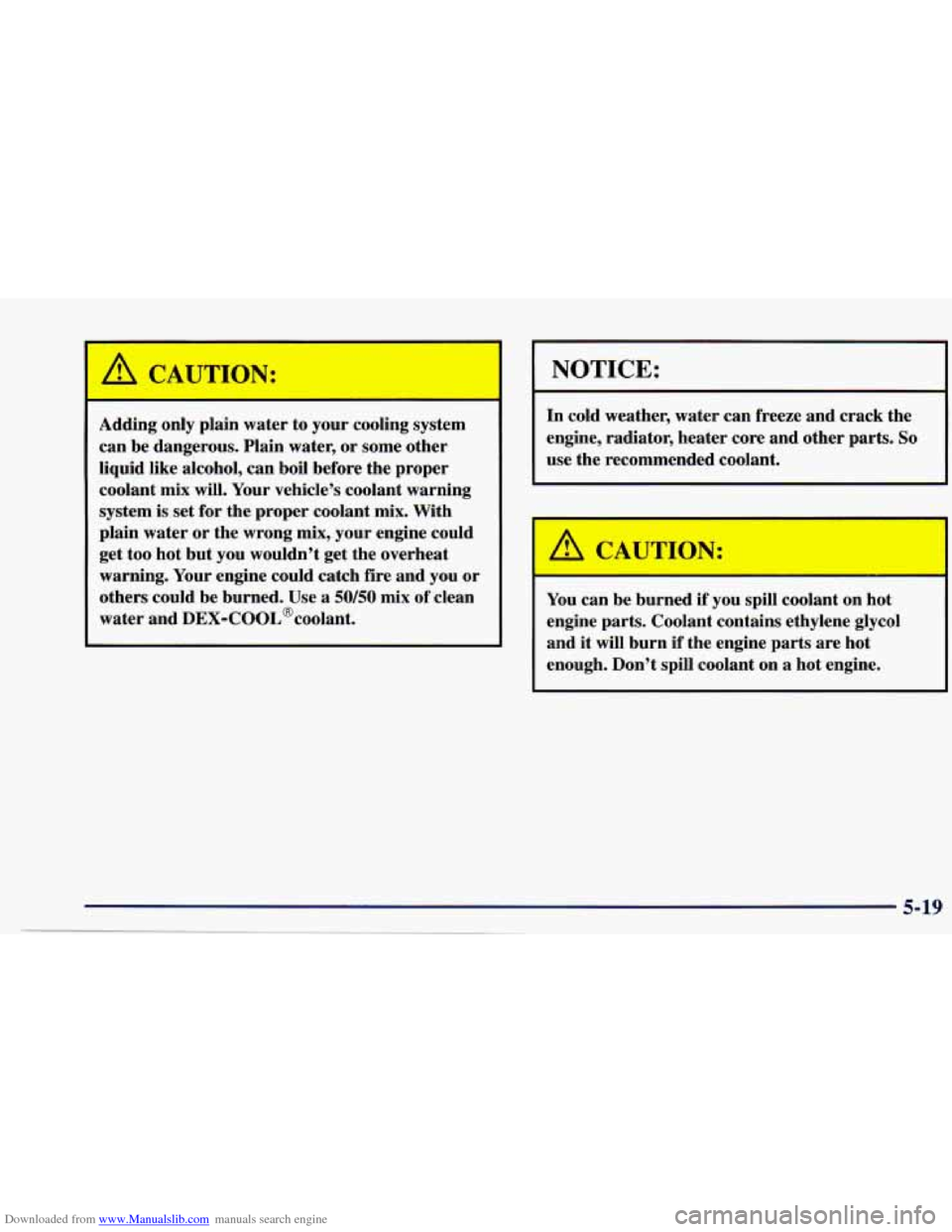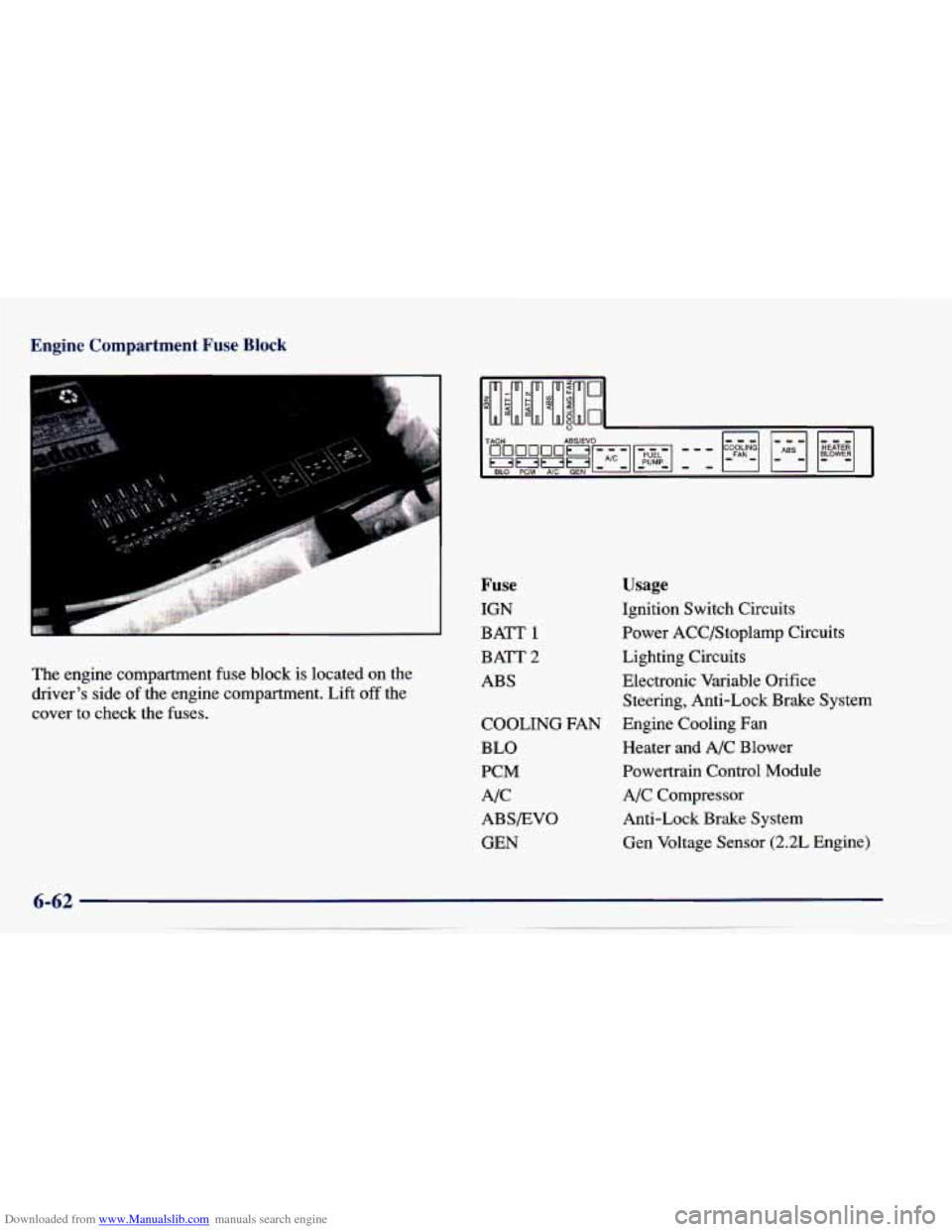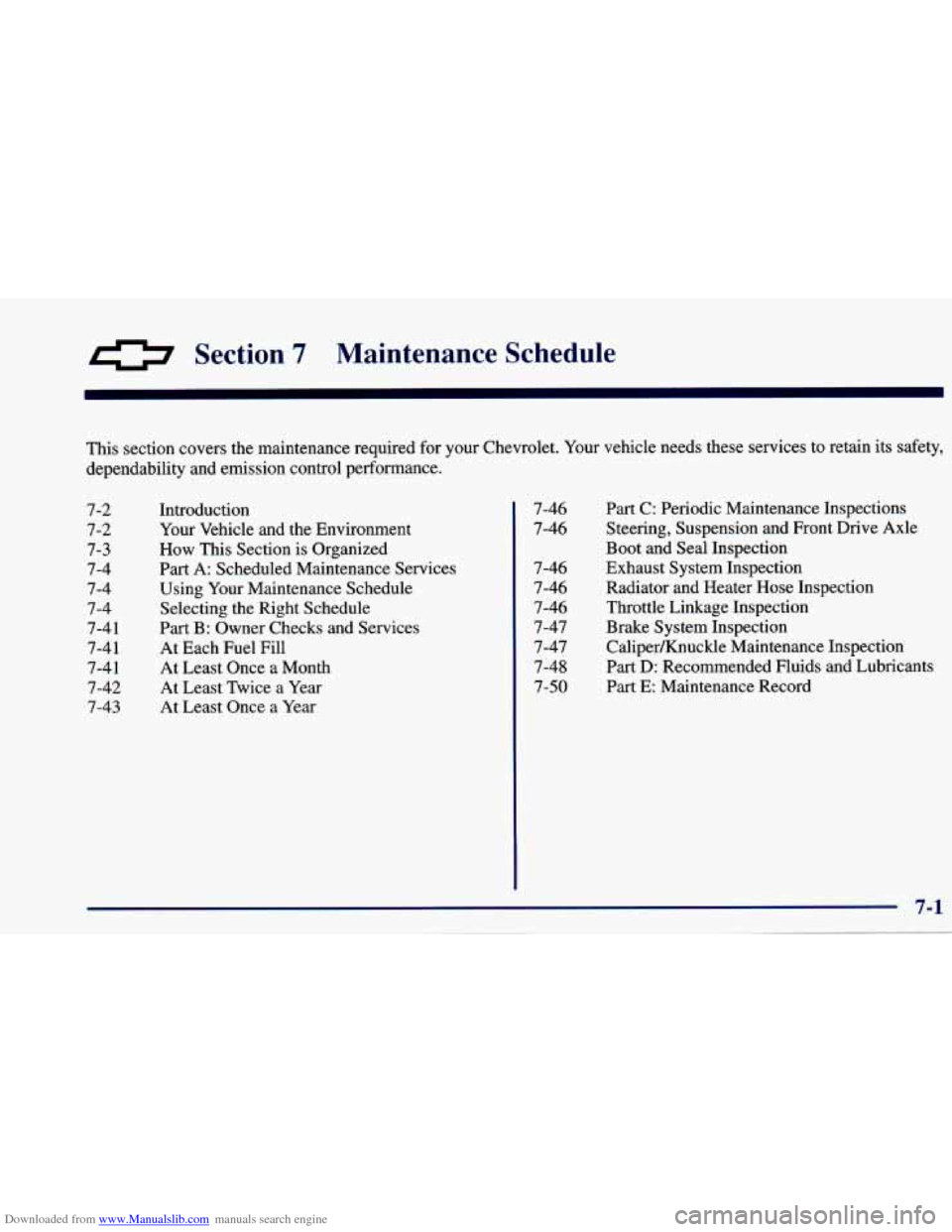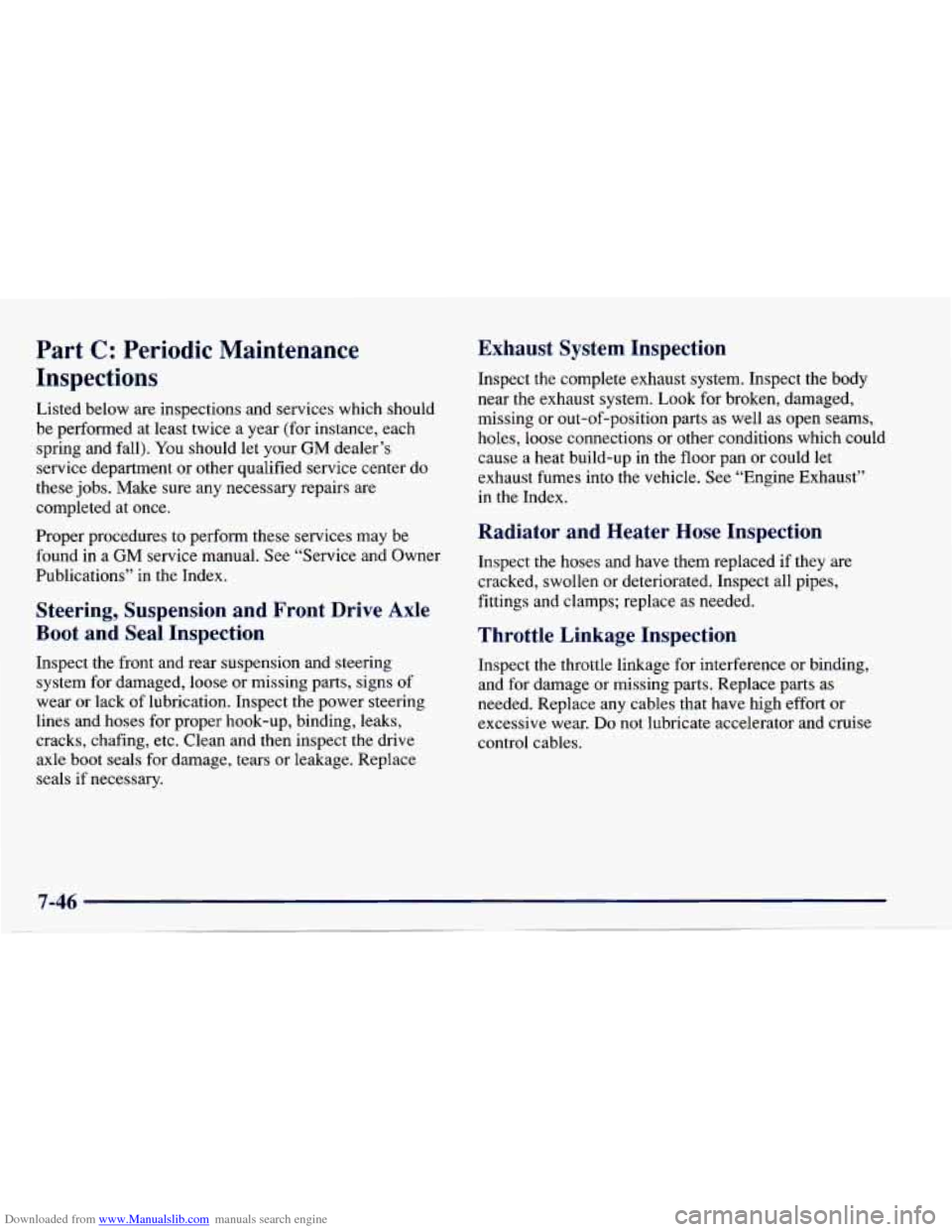1997 CHEVROLET CAVALIER heater
[x] Cancel search: heaterPage 225 of 388

Downloaded from www.Manualslib.com manuals search engine A CAUTION:
Adding only plain water to your cooling system
can be dangerous. Plain water, or some other
liquid like alcohol, can boil before the proper
coolant mix
will. Your vehicle’s coolant warning
system is set for the proper coolant mix. With
plain water
or the wrong mix, your engine could
get too hot but you wouldn’t get the overheat
warning, Your engine could catch fire and you or
others could be burned. Use a
50/50 mix of clean
water and DEX-COOL@coolant.
NOTICE:
In cold weather, water can freeze and crack the
engine, radiator, heater core and other parts.
So
use the recommended coolant.
A CAUTION:
You can be burned if you spill coolant on hot
engine parts. Coolant contains ethylene glycol
and
it will burn if the engine parts are hot
enough. Don’t spill coolant on a hot engine.
Page 267 of 388

Downloaded from www.Manualslib.com manuals search engine How to Check
You do not need to check the fluid level unless you
suspect
a clutch problem. To check the fluid level, take
the cap
off. If the fluid reaches the step inside the
reservoir, the fluid level
is correct.
Engine Coolant
The cooling system in your vehicle is filled
with DEX-COOL@ engine coolant. This coolant
is designed to remain in your vehicle for
5 years or
150,000 miles (240 000 km), whichever occurs first,
if you add only DEX-COOL@ extended life coolant.
The following explains your cooling system and how to add
coolant when it is low.
If you have a problem with engine
overheating, see “Engine Overheating”
in the Index.
A 50/50 mixture of water and DEX-COOL@ coolant will:
0 Give freezing protection down to -34°F (-37°C).
0 Give boiling protection up to 265 “F (129°C).
0 Protect against rust and corrosion.
0 Help keep the proper engine temperature.
Let the warning lights and gages work as
they should.
NOTICE:
I
When adding coolant, it is important that you
use only
DEX-COOL@ (silicate-free) coolant.
If coolant other than
DEX-COOL’ is added
to the system, premature engine, heater core or
radiator corrosion may result. In addition, the
engine coolant will require change sooner
-- at
30,000 miles (50 000 km) or 24 months, whichever
occurs
first. Damage caused by the use of coolant
other than
DEX-COOL@ is not covered by your
new vehicle warranty.
Page 268 of 388

Downloaded from www.Manualslib.com manuals search engine What to Use
Use a mixture of one-half clean water (preferably
distilled) and one-half
DEX-COOL@ coolant which
won’t damage aluminum
parts. Use GM Engine
Coolant If you use this mixture, you don’t need to add
anything else.
Adding only plain water
to your cooling system
can be dangerous. Plain water, or some other
liquid like alcohol, can boil before the proper
coolant mix will. Your vehicle’s coolant warning
system is set for the proper coolant mix. With
plain water or the wrong mix, your engine could
get too hot but you wouldn’t get the overheat
warning. Your engine could catch fire and you
or
others could be burned. Use a 50/50 mix of clean
water and
DEX-COOL@ coolant.
NOTICE:
If you use an improper coolant mix, your engine
could overheat and be badly damaged. The
repair cost wouldn’t be
covered by your
warranty. Too much water in the mix can freeze
and crack the engine, radiator, heater core and
other parts.
[f you have to add coolant more than four times a year,
lave your dealer check your cooling system.
NOTICE:
If you use the proper coolant, you don’t have to
add extra inhibitors or additives which claim to
improve the system. These can be harmful.
Page 303 of 388

Downloaded from www.Manualslib.com manuals search engine Fuse
WIPER
ERLS
AIR BAG
EXT LAMP
PWR ACC
HVAC
RADIO
ALARM
CRUISE
L HDLP
CIG
Usage
Windshield Wipers,
Windshield Washers
Automatic Transaxle, Brake
Transaxle Shift Interlock, A/C
Compressor, Cruise Control,
Multiport Fuel Injection
Supplemental Inflatable
Restraint System
Exterior Lamps, Instrument
Panel Lights
Power Door Locks, Convertible
Top (Convertible Model)
Heater and A/C Control,
Anti-lock Brake System,
Engine Cooling Fan
Radio, Remote Keyless Entry
Alarm Module
- Interior Lamps,
Warning Chimes
Cruise Control
Left Headlamp Cigarette Lighter,
Horn, Interior
Lamps, Diagnostic Connector
Fuse
INST LPS
STOP HAZ
PWR WIN- DOW
PCM/IGN
INT LAMP
FOG LAMP
IGN
R HDLP
Usage
Instrument Panel Lights,
Warning Chimes
Exterior Lamps, Anti-Lock
Brake System, Cruise Control,
Turn Signals
Power Windows, Power Sunroof,
Convertible Top Controls
(Convertible Model)
(Circuit Breaker)
Powertrain Control Module
Alarm Module: Illuminated Entry,
Warning Chimes, Overhead
Lamps, Mapmeading Lamps,
Glove Box Lamp, Trunk Lamp,
Radio, Power Mirrors, Remote
Keyless Entry
Fog Lamps
(2-24 Only)
Engine Ignition
Right Headlamp
6-61
Page 304 of 388

Downloaded from www.Manualslib.com manuals search engine Engine Compartment Fuse Block
P
The engine compment fuse block is located on the
driver’s side of the engine compartment. Lift off the
cover to check the fuses.
Fuse
IGN
BATT
1
BATT 2
ABS
Usage
Ignition Switch Circuits
Power ACC/Stoplamp Circuits
Lighting Circuits
Electronic Variable Orifice Steering, Anti-Lock Brake System
COOLING FAN Engine
Cooling Fan
BLO Heater and A/C Blower
PCM Powertrain Control Module
AIC A/C Compressor
ABS/EVO Anti-Lock Brake System
GEN Gen Voltage Sensor (2.2L Engine)
Page 309 of 388

Downloaded from www.Manualslib.com manuals search engine 0 Section 7 Maintenance Schedule
This section covers the maintenance required for your Chevrolet. Your vehicle needs these services to retain its safety,
dependability and emission control performance.
7-2
7-2
7-3
7-4
7-4
7-4 7-4
1
7-4 1
7-4 1
7-42
7-43
Introduction Your Vehicle and the Environment
How This Section
is Organized
Part A: Scheduled Maintenance Services
Using Your Maintenance Schedule
Selecting the Right Schedule
Part B: Owner Checks and Services
At Each Fuel Fill
At Least Once
a Month
At Least Twice
a Year
At Least Once a Year
7-46
7-46
7-46
7-46
7-46
7-47
7-47
7-48
7-50 Part C: Periodic Maintenance Inspections
Steering, Suspension and Front Drive Axle
Boot and Seal Inspection
Exhaust System Inspection
Radiator and Heater Hose Inspection
Throttle Linkage Inspection
Brake System Inspection
CaliperKnuckle Maintenance Inspection
Part
D: Recommended Fluids and Lubricants
Part E: Maintenance Record
Page 354 of 388

Downloaded from www.Manualslib.com manuals search engine Part C: Periodic Maintenance
Inspections
Listed below are inspections and services which should
be performed at least twice a year (for instance, each
spring and fall).
You should let your GM dealer’s
service department or other qualified service center do
these jobs. Make sure any necessary repairs are
completed at once.
Proper procedures to perform these services may be
found in a
GM service manual. See “Service and Owner
Publications” in the Index.
Steering, Suspension and Front Drive Axle
Boot and Seal Inspection
Inspect the front and rear suspension and steering
system for damaged, loose or missing parts, signs
of
wear or lack of lubrication. Inspect the power steering
lines and hoses for proper hook-up, binding, leaks,
cracks, chafing, etc. Clean and then inspect the drive axle boot seals for damage, tears or leakage. Replace
seals if necessary.
I
Exhaust System Inspection
Inspect the complete exhaust system. Inspect the body
near the exhaust system.
Look for broken, damaged,
missing
or out-of-position parts as well as open seams,
holes, loose connections or other conditions which could
cause a heat build-up in the floor pan or could let
exhaust fumes into the vehicle. See “Engine Exhaust’’
in the Index.
Radiator and Heater Hose Inspection
Inspect the hoses and have them replaced if they are
cracked, swollen or deteriorated. Inspect all pipes,
fittings and clamps; replace as needed.
Throttle Linkage Inspection
Inspect the throttle linkage for interference or binding,
and for damage or missing parts. Replace parts as
needed. Replace any cables that have high effort or
excessive wear.
Do not lubricate accelerator and cruise
control cables.
Page 377 of 388

Downloaded from www.Manualslib.com manuals search engine Cleaning ...................................... 6-49
AluminumWheels
............................ 6-55
Convertible Top
.............................. 6-54
Exterior LampLenses
......................... 6-53
Fabric
...................................... 6-49
Glass Surfaces
............................... 6-52
Inside of Your Chevrolet
....................... 6-49
Instrument Panel
............................. 6-51
Outside
of Your Chevrolet ...................... 6-53
Special Problems
............................. 6-50
Stains
...................................... 6-50
Tires
....................................... 6-55
Vinyl
....................................... 6-51
Wheels
..................................... 6-55
Windshield and Wiper Blades ................... 6-52
Climate Control System, Standard
................... 3-2
Climate Control System with Air Conditioning
......... 3-3
Clock, Setting the
................................ 3-8
Clutch Fluid, Hydraulic
.......................... 6-24
Clutch, Hydraulic
............................... 6-24
Comfort Controls
................................ 3 - 1
Compact Disc Adapter Kit ........................ 3-17
Compact Disc Care ............................. 3-25
Player
...................................... 3-17
Theft-Deterrent Feature
........................ 3-21
Compact Spare Tire
............................. 5-34
Control of a Vehicle
.............................. 4-6
Convenience Net
............................... 2-49
Convertible Top
Cleaning
.................................... 6-54
Installing
the Boot ............................ 2-53
Lowering
................................... 2-52
Lowering Manually
........................... 2-59
Operation
................................... 2-5 1
Raising ..................................... 2-58
Raising Manually
............................. 2-59
Removing the Boot
........................... 2-56
Convex Outside Mirror
.......................... 2-48
Coolant
....................................... 6-25
Heater. Engine
............................... 2-17
Surge Tank Pressure Cap ....................... 6-28
Cooling System
................................ 5-16
Courtesy Transportation ........................... 8-8
Cruise Control ................................. 2-38
Cupholders
.................................... 2-48
Customer Assistance for Text Telephone Users
......... 8-4
Customer Assistance Information
................... 8-1
Customer Satisfaction Procedure .................... 8-2
SurgeTank
.................................. 5-16
Damage.
Finish ............................... 6-56
Damage. Sheet Metal
............................ 6-55
Daytime Running Lamps/Automatic Light Control
.... 2-42
Dead Battery
................................... 5-3
Defects. Reporting Safety
........................ 8-10
Defensive Driving
............................... 4-2
Defogger. Rear Window
.......................... 3-7
Defogging
..................................... 3-7
Defrosting
..................................... 3-7
Dolby B Noise Reduction 3-16
Dome Lamp Bulb Replacement
.................... 6-39
DoorLocks
..................................... 2-4
Drive. Automatic Transaxle
....................... 2-21
Driver Position
................................. 1-13
Dimen ions. Vehicle
............................ 6-65 8 .......................
. .